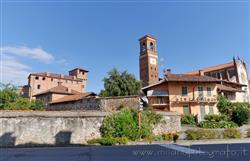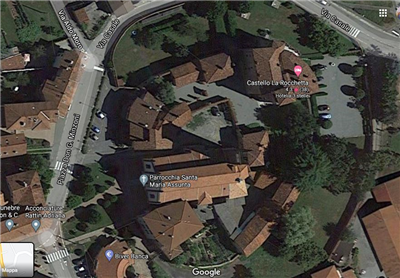|
Sandigliano (Biella)- Sandigliano
|
|
|
Show to visit in the Biella area: |
 Although presumably the town has Roman origins, the first confirmed document in which the name Sandigliano appears dates back to 996 and concerns the deed of sale of a land. Although presumably the town has Roman origins, the first confirmed document in which the name Sandigliano appears dates back to 996 and concerns the deed of sale of a land.
In 999 the town passed into the hands of the Bishops of Vercelli, who gave it as a fief to the Lords of Sandigliano and the Vialardi family.
The town was invaded by the Visconti troops in 1353, it was later also sacked by the army of Facino Cane during the struggles between the Visconti and the Savoy families for the possession of the Biella area.
Ceded by the Savoy themselves in part to the Vialardi and in part to the Avogadro (who made an act of submission to the Savoy), it was given to Sebastiano Ferrero in 1493.
Sandigliano was periodically subjected to looting (for example also in the seventeenth century, during the struggles between the French and the Spanish for the possession of northern Italy), forcing the inhabitants to find refuge in the nearby mountains.
To avert these dangers, the town began to be fortified already in the 14th century, by building two castles and a ricetto (fortified part of a town build by the people of the town) which, however, was already in ruins in 1575. It should be noted that from the ground the ricetto is no longer recognizable as a whole, and only single pieces of the perimeter wall of the ricetto (which had an ellipsoidal shape) can be seen. From above, however, it is very recognizable, as a whole series of buildings appear to have a side that supports what was originally its shape:

Although it is a town of just 2600 inhabitants, Sandigliano is full of things to see and even has two castles.
- Torrione Castle (Fig. 2): It is located at the exit of the village along the road to Borriana. It belonged and belongs to a branch of the noble Vialardi family, one of the oldest and most illustrious families in the Biellese area.
Some parts of it are unfortunately in a bad state of conservation, others were restored between 1920 and 1927 in a probably too free way.
The complex, which originally had an eminently defensive function, was built around the tower, called of Widolardo, which gives it its name and which is still well recognizable today. It is a massive keep with a rectangular section, just a little higher than the other buildings around it. It was originally crowned by a Guelph battlements, still recognizable. Today, however, it is equipped with a roof and decorated with bricks arranged in a sawtooth. It is not clear exactly whwn it was built, its dating varies from the tenth to the thirteenth century.
Gradually the keep was surrounded by various buildings, including, in the fifteenth century, the main body of the castle. Various pieces of masonry built with river pebbles arranged in a herringbone pattern, as was typical for that era, are well recognizable.
In the sixteenth and seventeenth centuries further elements were added and the complex lost its defensive function, transforming itself into a stately home. In particular, in 1559 Manfredo Vialardi, count of Sandigliano and Villanova, raised the fortress by one floor. Between 1608 and 1610 Agostino Vialardi restructured the entire complex.
The entrance gate was demolished in the nineteenth century.
A characterizing element of the castle is the bertesca, that is a small cantilevered turret built on a corner of a building, which rises towards the street from one of the elements of the complex. It is equipped with large machicolations, false merlons and an ogival window.
The main body, on the other hand, is enriched by ogival mullioned windows and saw-toothed brick frames.
Inside the castle there are numerous pictorial decorations in the form of frescoed vaults and friezes in the upper part of the walls.
The castle is currently not open to visitors.
- La Rocchetta Castle (Fig. 4): It is located in the center of the village, behind the parish church of Santa Maria Assunta. Built in the fourteenth century, it was adjacent to the ricetto, but was nevertheless separated from it.
The castle has undergone many changes over the centuries. Its current appearance, however, dates back mainly to the fifteenth century.
Since 2010 it has been transformed into an accommodation facility comprising 16 apartments of great charm, for both short and long-term stays.
La Rocchetta Castle in more detail
- Parish Church of Santa Maria Assunta (Fig. 1): It was built in 1878 in Neo-Gothic style on project by Edoardo Arborio Mella, after the previous church of the fifteenth century had collapsed, fortunately without causing damage to people.
The bell tower was built on the base of the tower formerly used as a prison.
Inside it preserves frescoes detached from the Church of the brotherhood of Saints Bernard and Charles and painted in 1526 by a Novara school painter from the circle of Daniele De Bosis's children: a polyptych with the Virgin with Child in the center, the Blessed Pietro Levita, the Saints Rocco, Fabiano and Sebastiano and another Virgin with Child.
There are also some valuable stained glass windows, as well as the icon of the Assumption, the work of the painter Gamba, and a "Via Crucis" painted by the painter Ciardi in 1889.
- Oratory of St. Anthony Abbot (Fig. 4): It is a small building in style at the turn of Romanesque and Gothic erected probably at the end of the thirteenth century or the beginning of the fourteenth. It is also known as the Oratory of Sant'Antonio at the Tower due to the fact that it is located near one of the two castles of the village. However, it must be said that it was probably never the chapel of the adjacent castle, since it was never included in its walls.
Its most important element is given by the fifteenth-century frescoes that decorate the interior of the apse and which are attributed to the so-called Master of Christ of Sunday, from the fresco found in the Cathedral of Biella. On the left wall there is also a beautiful fresco depicting a Madonna enthroned with Child attributed to the workshop of Daniele de Bosis.
Oratory of St. Anthony Abbot more in detail
- Church of Santa Maria delle Grazie del Barazzone: also known as the Church of Our Lady of Loreto or simply Church of the Barazzone, it is located just outside the town, on the road to Candelo.
It is the result of a seventeenth-century extension of a smaller sixteenth-century original church which is thought have coincided with the left aisle. Inside there are, among other things, a fresco of the Nativity attributed to the workshop of Daniele de Bosis (therefore a fresco from the first part of the sixteenth century) in the left apse, a polychrome marble altar from 1784 and, on the back wall of the central apse, a valuable retable in carved and gilded wood decorated with floral motifs and cherub heads.
Church of Santa Maria delle Grazie del Barazzone more in detail
- Sanctuary of the Virgin of the Boscazzo: Also known more simply as the Church or the Oratory of the Virgin of the Boscazzo, it is located in the fraction Boscazzo, rather far from the town center.
The small sanctuary was born as a fifteenth-century oratory dedicated to the saints Fabiano and Sebastian and to the Virgin of the Boscazzo. In the sixteenth century, however, the dedication to the two saints was lost and only that to the Virgin remained.
The retable of the altar contains, as altarpiece, the (modified) fresco of the Virgin which was originally on a wall of the old church.
The fresco is attributed to Gaspare da Ponderano and therefore dates between the end of the fifteenth and the beginning of the sixteenth century.
Sanctuary of the Virgin of the Boscazzo more in detail
Categories: Places of historical value of artistic value
Sandigliano (Biella) |
Sandigliano: Further pictures in the section Photography |